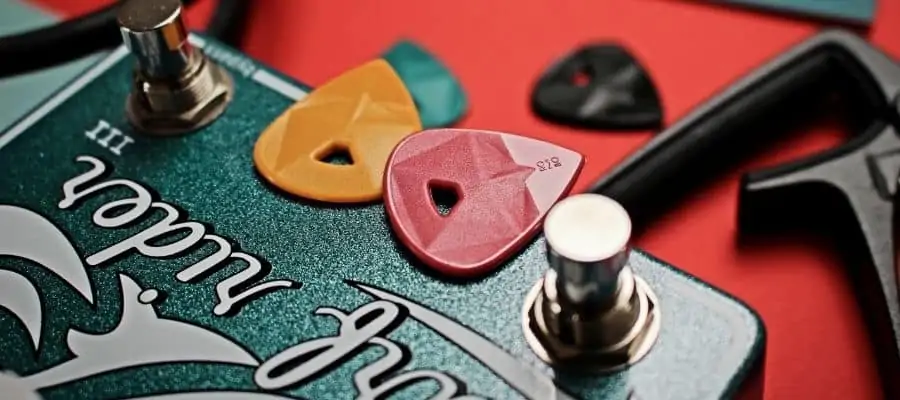Those who’ve been playing guitar for a while know that even the smallest details can make a difference in your performance and overall playing experience. One feature some guitarists tend to overlook is pick thickness. And while we already know that thicker guitar picks can help enhance tone and are more durable, can they actually improve your playing speed?
Thicker guitar picks aren’t necessarily better for speed, but neither are their thinner counterparts. While thicker models provide more resistance, making it easier to maintain control while playing fast, thinner picks are more flexible and ergonomic so that both variations can encourage speed.
Thinner picks are generally better for playing multiple notes and chords, while thicker picks provide better single-note control. Also, other factors play a role, such as thinner picks being easier to hold and the thicker picks providing a more focused and rounder tone.
Below, I’ll expand on how guitar pick thickness can affect speed and how you can make a well-informed decision on which variation would suit your preferences and playing style best. I’ll also go over some of the best ways to improve playing speed that don’t revolve around finding a pick of a certain thickness level, so if that’s your goal, make sure to read on until the end.
How Guitar Pick Thickness Affects Speed

Though pick thickness can impact playing speed, that impact isn’t always straightforward or easy to generalize.
For example, as mentioned above, both thick and thin variations can positively affect speed in certain circumstances. Hence, it’s impossible to tell whether one’s actually better than the other in this context.
Thicker picks will provide more resistance when striking the strings, making it easier to maintain control and precision even when experimenting with faster speeds. That’s because these picks require more force to move through the strings, requiring you to keep a more consistent attack. So, with thick picks, you have more control over your dynamics when playing single notes.
However, thick picks are also notoriously inflexible, making it harder to play multiple notes and chords. This lack of movement makes the material far less ergonomic, making it more difficult to pass the pick quickly through the strings.
Thicker picks are good for techniques like alternative and tremolo picking, but if you play too aggressively, they can break the strings more easily than thinner picks.
As you can see, variables such as your playing style, material quality, and external circumstances you have no control over can all affect the impact that a thicker pick will have on your playing speed.
By this point, you might wonder how thinner models compare.
Thinner picks boast more flexibility, making playing fast chord progressions easier. This level of flexibility makes the material more ergonomic and, thus, better able to slide through the strings easily.
Also, thinner picks are easier to hold than thicker picks, as thicker picks fight with more string resistance.
With all that said, thinner picks are also more prone to breaking, especially if someone tends to get more forceful as they start playing faster, which makes reaching greater speeds a no-go.
Another point is that thinner picks provide a more snappy and airy tone, while thicker picks have a rounder and more focused tone.
Considering all of the points above, it becomes clear that the impact of pick thickness on playing speed will depend on each player’s technique, personal preferences, experience level, and playing style.
Moreover, remember that factors such as pick material and shape can also affect your performance and tone, so it’s challenging to compare two pick categories (thin and thick) in a generalized manner without knowing which two particular models are being compared.
How To Choose the Right Pick Thickness

If you’re on the market for a new set of picks and were hoping to narrow down your choices based on which option would serve your playing speed, you’re not out of luck just yet. There are still a few technical and personal considerations to be made that can help you choose the pick thickness level that’ll serve you best.
Here’s what you’ll want to keep in mind:
- Your preferred music genre. Explosive, dynamic genres like metal or hard rock will benefit from the use of a thicker, more durable pick. On the other hand, if you favor acoustic or folk music, the gentleness that comes with thinner models might serve you best.
- Your playing style. Again, you’ll want to consider how aggressive or gentle your overall technique is and decide based on that.
- Your guitar model. Thicker picks are better suited to electric guitars with high-gauge strings, whereas their thinner counterparts are perfect for guitars with thinner strings.
Also, you must note that thinner picks have an airier and snappier tone, while thicker picks have a rounder and more focused sound. So, your desired tone should also play a role in your pick choice.
Ultimately, your best bet is to experiment with different pick thicknesses until you find out what works for you. Try to focus on the playability, feel, and sound you get from different picks. Maybe you will find the perfect sweet spot for your playing style or go with different picks for different genres and desired tones.
Alternative Ways To Improve Playing Speed

Since choosing a specific type of pick likely won’t have a notable effect on your playing speed, let’s explore some alternative methods you can use to improve this technical ability of yours.
- Perfect your technique. Before even considering speeding up, you’ll want to ensure you can play a certain partition accurately first. Only then you can start trying to play it faster until your fingers become accustomed to the movement.
- Practice with a metronome. A metronome helps you develop a consistent sense of timing, which allows you to play with a steady speed as you gradually increase your tempo.
- Warm-up. If you go into an intense playing session without warming up first, you’re asking for inaccuracies at best and for cramps at worst. Warming up can help you loosen up your muscles and promote blood circulation in your hands, which can help improve your playing speed while reducing the risk of injury.
- Use alternate picking. Alternate picking involves using a downstroke directly, followed by an upstroke. Perfecting this technique can help optimize your dexterity and overall speed without sacrificing accuracy.
- Practice regularly. This is arguably the best advice I can give you, as no matter how many smart tips and tricks you apply to your practice routine, you’ll never be able to get better as long as you don’t put in the proper time and effort.
Conclusion
Though some guitarists might find that thicker picks help them play faster and more accurately, others prefer the flexibility of a thinner model. There’s no one-size-fits-all answer to the question of which pick thickness will affect your playing speed the most, so your best bet is to experiment with different variations until you find what works for you.
The ideal pick thickness for you will largely depend on your music genre, playing style, and guitar model rather than your goal playing speed, so keep that in mind next time you’re purchasing a new set of picks.
If you found this article useful, you may want to save this pin below to your Guitar board.

Recent Posts
Some guitarists insist on buying an expensive amplifier with their electric guitar. They assume that this is a must for every type of guitarist out there. However, in some situations, this isn’t...
Top 50 Free Realistic Guitar VST Plugins With Sound Examples
As technology has rapidly advanced in the recent decade, computers are stealing more and more roles from physical musical instruments and accessories. Nowadays, you do not need expensive amps,...

